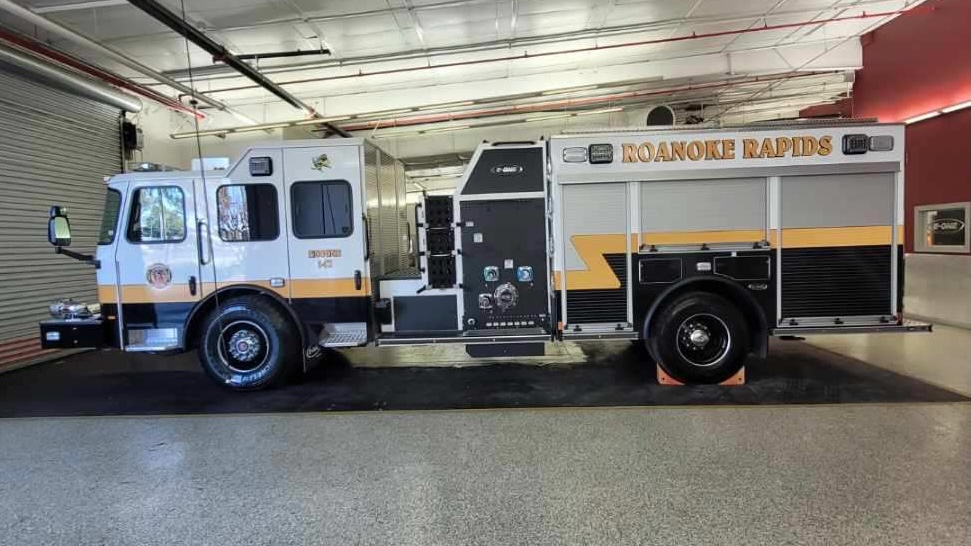It won’t be as long as it has been.
In fact, the Roanoke Rapids Fire Department’s new E-One pumper is at Fire Connections in Rocky Mount getting a couple of minor tweaks and equipment mounted, Assistant Chief Richard Cook said Tuesday.
Chief Jason Patrick said it is expected that the new truck, which will be based at Station 2, is destined for Roanoke Rapids by the middle to the end of May.
Funding for the truck came from a FEMA Assistance to Firefighters Grant and another truck the department will receive through American Rescue Plan Act funds is on order.
But with the new pumper now in Rocky Mount there is excitement within the RRFD.
“It’s going to give us the ability to put something new on the road that we don’t have to worry about breaking down,” Cook said. “It’s going to take one of our frontline apparatus and move that to a backup so it will give us a more dependable backup truck. The engine that it’s taking off the frontline is in Rocky Mount for its annual service so I’ve got a 33-year-old engine today on the road hopefully for the last time.”
When the new truck comes to Roanoke Rapids about the only thing firefighters will have to do is add the hoses. “We’ve got four pallets of hoses to put on as soon as it gets here,” Patrick said, along with a few minor things.
Like when its new ladder truck arrived in 2013, Patrick expects there will be a dedication ceremony for the new truck. “We’ve got to get in here and plan it. We’ve got to talk about it amongst ourselves but I do think that we’ll do some kind of dedication ceremony.”
Patrick said the new truck will replace Station 2’s first out truck which is now 19-years-old.
-
 Click to open image!
Click to open image!
Click to open image!
Click to open image!
-
 Click to open image!
Click to open image!
Click to open image!
Click to open image!
-
 Click to open image!
Click to open image!
Click to open image!
Click to open image!
-
 Click to open image!
Click to open image!
Click to open image!
Click to open image!
https://www.rrspin.com/news/8851-ready-for-arrival-rrfd-anticipates-delivery-of-new-pumper.html#sigProId8905792fd4
‘Ready for it to get here’
“I think everybody is ready for it to get here,” Cook said, especially with the current frontline truck being serviced right now.
“I think they’re pretty excited about getting some more reliable equipment to work with,” Patrick said.
Patrick expects the new truck will have a positive impact on the city’s ISO rating. “Once we get everything in place, yes, because we’ll get credit for a reserve truck where before we hadn’t.”
A truck by committee
The new truck is one that a committee pored over — 100 pages of details with hundreds of specs.
That committee was made up of Cook, Deputy Fire Marshal Kenneth Hollowell, Battalion Chief Chris Horvath, lieutenants Jonathan Woodall, Darrell Miles and Bryan Hollowell and Engineer Ben Clements.
“They had a pretty good blueprint of the truck they wanted,” Cook said. “We kind of tweaked it because of costs and technology. Batteries, tools and lights have come a long way. We didn’t get a generator on the truck.”
Said Patrick: “They sat down with the specs on the truck from the size of the frame rail that the truck rides on to the size of the axles to the size of the engine to the compartmentation. The committee went through this and decided this is what we want. We had different vendors come in to give us their drawings and their specifications on the truck and we bidded it out from that point.”
The generator was one of things that was ruled out, a piece of equipment that runs $25,000, Cook said.
“We don’t use a generator much,” Patrick said. “Over time the committee studied it a little bit and looked at it. The only time they use a generator is for the fan to remove the smoke. Moving forward with these trucks, these trucks are going to have 60-volt battery operated fans so we’re getting away from having electric stuff on there and going more with the battery stuff.
“Therefore we kind of saved that money on that truck by not getting the generator which is kind of a trend in the fire service anyway. It’s something you’re going to have to service to keep up but you’re not really using it.”
Other details studied
Their study also included other details of the new truck — anything from the color to the layout of the pump panel.
“The truck that’s 19-years-old, about four years ago we had to replace the cylinders in the ladder rack,” Patrick said.
On the new truck the committee specified to have it tunneled so the ladders go inside the truck instead of having a ladder rack. “To repair a ladder rack is $6,000. To put it on the truck was probably $10,000. So we were looking at $10,000 extra to have something put on the truck so when it goes bad, and it’s not if it’s when, it could cost us up to $6,000 again. Or we could put a chute in the back of the truck where the ladder slides in the back. There’s not as much cost to it and it keeps the ladder out of the weather and what’s going to go bad with it? Nothing. There’s nothing mechanical about it. It slides in the back.”
Those were some of the things that the truck committee did to try to reduce the cost in the long run, the chief said.
Patrick commended the committee for its work. “Everyone of them did a good job. A lot of times when departments do this all they’re looking at is minute things, they don’t get into the details as much as these guys did. These guys tried to utilize and get what was beneficial to us as a department and what suited what we needed and not overspend. We could have easily put $25,000 in a generator but if you’re not going to use it, what purpose is it to have it? If you’re only going to use it once a year then what purpose is it?”
There will be a small learning curve when the new truck arrives, Cook said. “It’ll be a lot like they’re operating now.”
Said Patrick: “Every vehicle you get in is a little bit different. When we bring them in naturally there’s going to be some training for them to get accustomed to it a little bit and do a little driving and a little pumping. Overall there’s not going to be that big of a difference.”
Cook looks at the future benefits. “It’ll definitely get us in a good place. We hadn’t been there for a long time.”








